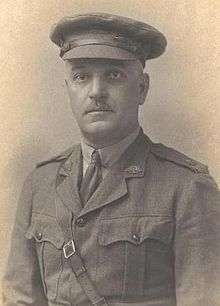Alexander Hay (Australian politician)
Alexander Hay (8 January 1865 – 8 May 1941) was a New Zealand-born Australian pastoralist, businessman and politician. He was a member of the Australian House of Representatives from 1919 to 1922, representing the electorate of New England for the Nationalist Party (1919-1920), Country Party (1920-1921) and as an independent (1921-1922).
Alexander Hay | |
|---|---|
 | |
| Member of the Australian Parliament for New England | |
| In office 13 December 1919 – 16 December 1922 | |
| Preceded by | Percy Abbott |
| Succeeded by | Victor Thompson |
| Personal details | |
| Born | 8 January 1865 Auckland, New Zealand |
| Died | 8 May 1941 (aged 76) |
| Nationality | New Zealand Australian |
| Political party | Nationalist (1919–20) Country (1920–21) Independent (1921–22) |
| Occupation | Farmer |
Hay was born at Parua Bay in New Zealand and was educated at Auckland Grammar School. He migrated to Australia in 1893 and visited England for the purposes of importing cattle in 1894. His brother, Sir John Hay, had inherited the substantial Berry Estate and Coolangatta Estate following the death of his cousin, David Berry, and in 1895 Alexander Hay joined his brother in managing the estates. They undertook a significant development project which saw about 400 freeholders settled onto the land, while retaining the Coolangatta Homestead as their own. Along with his brother, he was heavily involved in the development of the Berry Central Butter Factory. Hay subsequently undertook successful investments in pastoral properties in Queensland, which he in turn invested into mining concerns in New South Wales, including the Mount Royal Copper Mine, and rubber interests in the Territory of Papua. He was an unsuccessful candidate at the first federal election as a Protectionist and again in 1914 for the Commonwealth Liberal Party. Hay enlisted for service in World War I in October 1915 in the 2nd Remount Unit and was posted to Egypt; he was promoted to major during his deployment and returned to Australia in 1916.[1][2][3][4][5]
In 1919, he was elected to the House of Representatives as a Nationalist, representing the seat of New England. He had also been endorsed by the Farmers and Settlers' Association, and joined the Country Party when it was formed in 1920. His tendency to vote against his party resulted in his expulsion in October 1921 after he saved the Hughes Nationalist government from defeat by voting against a Country Party censure motion. He contested the 1922 federal election as an independent but was unsuccessful.[6][4]
He retired from politics and returned to his farming and business interests after his 1922 defeat. He died at Coolangatta Estate in 1941.[7][6][8]
References
- "The Man for New England". The Armidale Chronicle. New South Wales, Australia. 6 December 1919. p. 10. Retrieved 23 December 2019 – via Trove.
- "M. A. P." Illawarra Mercury. New South Wales, Australia. 16 May 1941. p. 9. Retrieved 23 December 2019 – via Trove.
- "THE BERRY CENTRAL BUTTER FACTORY". The Daily Telegraph. New South Wales, Australia. 21 August 1896. p. 7. Retrieved 23 December 2019 – via Trove.
- "Replica of Mr. Alex. Hay". The Nowra Leader. New South Wales, Australia. 1 May 1925. p. 8. Retrieved 23 December 2019 – via Trove.
- "Commonwealth Members of Parliament who have served in war: Colonial wars and the First World War". Parliament of Australia. Retrieved 23 December 2019.
- "PERSONAL". The Herald. Victoria, Australia. 9 May 1941. p. 11. Retrieved 23 December 2019 – via Trove.
- Carr, Adam (2008). "Australian Election Archive". Psephos, Adam Carr's Election Archive. Archived from the original on 14 May 2008. Retrieved 24 May 2008.
- "Family Notices". The Sydney Morning Herald. New South Wales, Australia. 9 May 1941. p. 10. Retrieved 23 December 2019 – via Trove.
| Parliament of Australia | ||
|---|---|---|
| Preceded by Percy Abbott |
Member for New England 1919 – 1922 |
Succeeded by Victor Thompson |